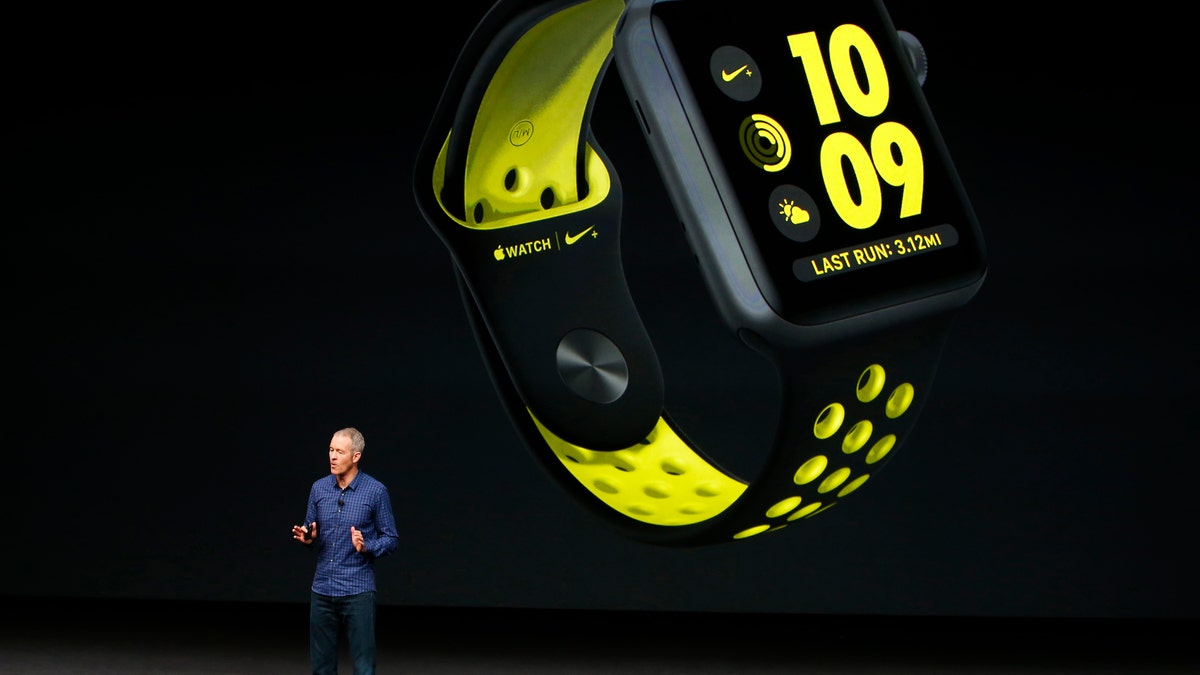
Apple Inc. COO Jeff Williams discusses the Apple Watch Series 2 with Nike+ during a media event in San Francisco, California, U.S. September 7, 2016. (REUTERS/Beck Diefenbach)
Wearable devices are gaining in popularity, even if smartwatches are still battling to win over consumers. Here are some of the best in 2016.
Basic wearables – mostly fitness bands – accounted for 85 percent of the wearables market and saw steady growth in the third quarter of this year, according to IDC, which added that “simplicity is a driving factor” behind their popularity.
“Smart wearables,” such as smartwatches, on the other hand, are seeing a more muted acceptance among consumers, IDC said.
Here’s the top 5 list, starting with two smartwatches and ending with three popular, proven fitness trackers.
Apple Watch 2: The first hardware update to the Apple Watch since it was introduced in April of 2015 is cosmetically unchanged, except for being slightly thicker to accommodate a larger battery. Otherwise, the Apple Watch Series 2 is faster– due to new silicon– features built-in GPS (to make it more independent of the iPhone) and is now waterproof. It’s also a good fitness and health tracker, can handle email and messaging, take phone calls, and be used as a digital wallet via Apple Pay. New Watch packages like the Apple Watch Nike+ are attractive because they’re no more expensive than the cheapest Apple Watch 2, and come with recognized branding and cool bands. Apple Watch Series 1 (which is still being sold) starts at $269, and Apple Watch 2 starts at $369.
APPLE WATCH NIKE+ COMING SOON, UPS FITNESS ANTE
Samsung Gear S2/S3: Last year’s Samsung Gear S2 is still one of the best smartwatches. The rotating bezel, classic circular screen, and Super AMOLED display make it a standout. Recently, Samsung introduced the Gear S3, a larger watch than the Gear S2. (The downside being the S3 may not be a good fit for some, due to its size.) The Watch’s design is still striking, and the S3 has a better rotating bezel and improved display. A LTE version of the Gear S3 is available with cellular service provided by AT&T or T-Mobile. Onboard GPS is included on all watches. And, like Apple, Samsung has a focus on fitness, supported by Samsung apps and an evolving Samsung S Health platform. Samsung Pay (which allows purchases, including a limited number independent of the phone) comes with the watch too. Note that the Gear S2/S3 run a separate operating system (Tizen) from Google’s Android Wear. This means there’s a relative dearth of apps. There is support for connecting to non-Samsung Android phones, though. The S3 is not waterproof (i.e., it’s not swimproof) like the Apple Watch 2. The Samsung Gear S2 starts at $249.99 and the S3 starts at $349.99.
Fitbit Charge 2: The Charge 2 is the top fitness tracker. The release of the Charge 2 earlier this fall helped to secure Fitbit as the No.1 worldwide wearable device vendor (based on shipments) in the third quarter, according to IDC. Highlights include a large OLED display that can simultaneously show time and fitness data, an always-on heart rate monitor, long battery life, swappable bands, and, as always, excellent fitness tracking. Lacks a built-in GPS (but can pull in GPS data from a phone) and is not waterproof. Price: $149.95.
Garmin Vivosmart HR+: This wearable device often makes it to the top of fitness tracker review lists. It offers built-in GPS, lots of activity tracking, and heart rate. Battery lasts up to a week and it’s water resistant. One of the few downsides is that it’s a little on the bulky side. Regularly $199.99.
Samsung Gear Fit 2: The slim Gear Fit 2 sports an amazing Samsung curved AMOLED display and form-fitting wristband. The display combined with physical design comes pretty close to being a mini-smartwatch dedicated to fitness. Other highlights include smartphone notifications and automatic activity/sleep tracking. It also boasts built-in GPS, heart-rate monitoring, and 4GB of onboard music that you can control from your wrist. Relatively inexpensive compared to fitness tracking rivals in its class, Gear Fit 2 is priced at $179.99.




















